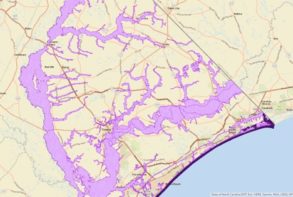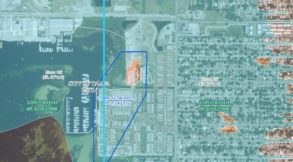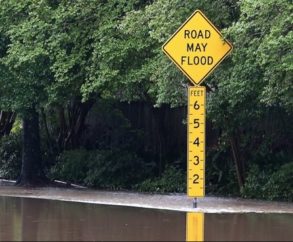
This article is a Contributor Post, and written by Erin Watson of Permits.com. If you are interested in the BuiltWorlds Contributor Program, click here.
Last week, I was planting this year’s garden. Today, I’m salvaging the belongings that matter most before flood waters creep past the threshold and destroy my home.
This is the reality many people face when a disaster comes knocking on your doorstep. Hurricanes, thunderstorms, and tornadoes all can be powerful in their own right, but they have one commonality that makes them equally costly and deadly — flooding. Each year, flooding tops the list as the number one natural disaster in the U.S. causing billions of dollars in substantial damages as a result of catastrophic events. Communities are ruined, homes are tarnished, and millions of people have their lives turned upside down in a matter of hours.
Many communities know the tragedies associated with flooding and the endless heartbreak that follows it. Most recently, Hurricane Florence carved a path of widespread damage throughout the Carolinas. Weeks later, residents were left reeling from the effects of record-setting flood events that closed schools and businesses for nearly a month. Fast forward a couple of months and there are still community members who have nothing left but a pile of rubble and a shell for a home. So who will help bring some normalcy back to these ransacked areas and save the day like Superman?
Floods, FIRMs, and FEMA, Oh My!

The United States government organized the Federal Emergency Management Agency (FEMA) in 1979 which enables federal relief to disaster-stricken areas. In flood-prone communities, FEMA enforces regulations to assist those in need when disaster strikes in an effort to bring affected families and businesses some sense of normalcy. To determine who these regulations are applicable to, the agency uses an internally created resource: Flood Insurance Rate Maps (FIRMs).
FIRMs are designed to show the existing floodplain boundaries based on historical data and regional development up to the date of design. By using these maps, FEMA can establish if your structure is within a floodplain and, if so, certain rules and regulations apply to your property. If you do reside in a floodplain, then your property is designated a Special Flood Hazard Area (SFHA). While FIRMs are undoubtedly essential when preparing for or reacting to natural disasters, they must be kept up-to-date accounting for changes in local landscapes and construction booms in order to provide the most accurate data for communities preparing for a major event.
Although up-to-date boundaries provide crucial data, it is only one piece of the puzzle. In the event that flooding is a realistic possibility in your area and you are in a flood zone, knowing if your community is part of the National Flood Insurance Program or NFIP, is critical. As long as your community is a member of NFIP, you are eligible for federal flood insurance, which is mandatory if you live in an SFHA or floodplain. For someone like me who lives in a Special Flood Hazard Area with flood insurance, all these federal policies sound like a great thing — and it is…but with these special programs also come special guidelines.
FIRMs are designed to show the existing floodplain boundaries based on historical data and regional development up to the date of design. By using these maps, FEMA can establish if your structure is within a floodplain and, if so, certain rules and regulations apply to your property. If you do reside in a floodplain, then your property is designated a Special Flood Hazard Area (SFHA). While FIRMs are undoubtedly essential when preparing for or reacting to natural disasters, they must be kept up-to-date accounting for changes in local landscapes and construction booms in order to provide the most accurate data for communities preparing for a major event.
Although up-to-date boundaries provide crucial data, it is only one piece of the puzzle. In the event that flooding is a realistic possibility in your area and you are in a flood zone, knowing if your community is part of the National Flood Insurance Program or NFIP, is critical. As long as your community is a member of NFIP, you are eligible for federal flood insurance, which is mandatory if you live in an SFHA or floodplain. For someone like me who lives in a Special Flood Hazard Area with flood insurance, all these federal policies sound like a great thing — and it is…but with these special programs also come special guidelines.
Making it complicated…50% of the time
The Substantial Damages and Substantial Improvements Rule, also known as the 50% Rule, is a federally mandated regulation that local municipalities must adhere to when repairing or rebuilding structures in a designated floodplain. It is important to know that the cause of damage is irrelevant when this policy is in play — rather, FEMA focuses their attention on the cost of repairs or improvements. The rule states if repairs or improvements are valued at more than 50% of the structure’s value, then the structure is considered substantially damaged and therefore requires improvements which naturally invoke special conditions. These conditions demand the structure be brought into compliance according to the area’s Base Flood Elevation (BFE) plus the local freeboard requirement.
Additionally, the agency encourages local municipalities to include a specified time frame for cumulative substantial improvements in their floodplain management plans. The recommended time frames are 1, 5, and 10 year periods. The meaning behind this measured madness is simple: bring flood-prone structures into compliance once the cumulative improvement value exceeds 50% with the hope of avoiding future substantial damages. The flipside is more difficult for unlucky areas such as Horry County, SC, where residents have taken three major blows in the past 3 years. In this coastal tourist county, the specified time period is five years according to the local ordinance. This means all substantial damages from 2015’s historic flood, 2016’s Hurricane Matthew and 2018’s Hurricane Florence are aggregated and if the total value exceeds 50% of the structure’s value, then the property owner must face the music: bring the home into compliance or be financially forced to abandon your property and risk foreclosure.
Seems pretty harsh, right? Unfortunately, many people have suffered from the devastating floods but have limited options for help when compliance issues arise because they were not in an area that required flood insurance. Additionally, contractors, real estate professionals, and big corporations have limited knowledge of this rule and the correlating conditions that must be met if damage repairs exceed fifty percent. Mike Rimoldi, MPA, a former Building Official in Hillsborough County, FL, and Certified Floodplain Manager, shares his expertise on floodplain and disaster management when describing the situation perfectly.
Roadmapping the Future…What are your options?
Once a structure’s improvements or repairs are defined as substantial, there are limited options a contractor or property owner can decide between when trying to stay in compliance.

By and large, FEMA would prefer an owner elevate their structure above the Base Flood Elevation, BFE, along with adhering to freeboard requirements set by the local ordinances. Freeboard is an additional height requirement above the BFE to the top of the lowest lying floor. Essentially, it acts as a buffer for added protection against a potential threat. For instance, if a structure was in a floodplain with a 10’ BFE and the ordinance required an additional 3’ freeboard, then the structure would need to be elevated to at least 13’ to be in compliance with FEMA and local regulations. While this option is the most defensive to potential disasters, it is also the most expensive.
Many factors come into play when calculating the cost of raising a building: type of foundation, number of stories, age, square footage, elevation height, and so on. When taking into consideration the multitude of factors, the cost of lifting a structure above the BFE plus local freeboard can realistically exceed one hundred thousand dollars. Affordability is simply not a term that is associated with FEMA elevation compliance, nor is an abundance of assistance. Most property owners rely on their insurance policies through the NFIP which offers Increased Cost of Compliance (ICC) coverage. This coverage will financially assist an owner with elevation costs up to $30,000 which is convenient but it covers only a small portion of the total cost. While some assistance is certainly better than no assistance, the reality is that funding through grants is slim to none in most cases for raising structures.
The best advice from Certified Floodplain Managers is to read through your insurance policies and make certain you understand your coverage before damaging events occur. In addition to insurance coverage, FEMA encourages property owners to apply for Disaster Loans through the Small Business Association. These loans are typically low interest and qualified personal borrowers may be approved up to $240,000 to assist with compliance costs and repairs. A disaster loan can certainly aide owners in a time of need to repair and elevate their property, but this is also a risky decision since this is an added monthly cost that FEMA funding will not repay on your behalf. Nonetheless, elevation is the most proactive, prepared, and preventative option available. If a property owner is capable of spending the money beforehand, then this option could prove cost-effective in the future concerning reduced insurance premiums and avoidance of additional damages.
If elevating the structure is simply out of the budget, then obtaining a private appraisal could help increase the structure’s value allowing for a larger scope of work to be completed. Private appraisals are relatively inexpensive when compared to the significant cost of lifting an entire house. Most owners can look at spending a few hundred dollars for a complete and thorough appraisal. While being mindful of one’s best financial interests, it is important to note that the goal is to raise the value enough to complete the proposed scope of work within 50% of the depreciated value. Truthfully, it is a rarity that a private appraisal will allow for all necessary repairs to be finished since the “target value” would need to be double the job cost. However, it may support a majority of the repairs whilst eliminating exponential compliance costs.
Lastly, the remaining option is reducing the scope below the targeted 50% value. If the scope is reduced, an owner and contractor would need to work together with the municipality to determine which repairs are necessary for occupancy and how to successfully complete construction while maintaining full compliance with federal and local regulations. Ultimately, the goal is to focus on the most important repairs to ensure the scope stays within 50% of the structure’s value. Additionally, it is best to be conscientious of the local cumulative timeframe for substantial improvements if the proposed work is at a minimum. This timeframe will overshadow any and all repairs made on the structure and, legally, an owner will not be able to finish repairs until the time period has lapsed or they produce a compliant flood elevation certificate proving the structure is above the set BFE.
No matter the outcome, owners are left in a serious bind when choosing how to move forward with property repairs. Each alternative has associated costs and risks; of the two least expensive choices, neither provides protection against future damage. Even a contractor has a difficult time advising property owners because of how significant the cost differences are and how much risk and uncertainty are at play with future events. Regardless of the building standards set upon by FEMA, there are challenges that arise along the way that seemingly impact a community as a whole.
Issues
While FEMA strives to prevent substantial damages by enforcing elevation requirements for new homes in a floodplain, their regulations have caused unforeseen issues for property owners, contractors, and corporations alike when dealing with existing flood prone structures. For instance, FIRMs are not up-to-date nor are they considered reliable by many municipal figures. Increasingly frequent storms at higher intensities as well as construction booms change the topography of the American landscape and contribute to the reasons why flood maps are not in coincidence with reality.
 Millions of people are considered to own property in a flood zone where it never floods; others reside in areas where it floods yearly but are not considered to be in an SFHA. These inconsistencies create a false sense of protection in some, and a false sense of fear in others. If local municipalities had more of a voice when determining SFHA’s and flood zone boundaries, then our society would have educated communities informed on flood mitigation because local experts were able to reliably caution people on realistic threats to their properties.
Millions of people are considered to own property in a flood zone where it never floods; others reside in areas where it floods yearly but are not considered to be in an SFHA. These inconsistencies create a false sense of protection in some, and a false sense of fear in others. If local municipalities had more of a voice when determining SFHA’s and flood zone boundaries, then our society would have educated communities informed on flood mitigation because local experts were able to reliably caution people on realistic threats to their properties.
In addition to outdated flood maps, owners are encouraged to apply for SBA disaster loans and increase their financial obligations to creditors. Sometimes, the monthly payments are close to or more than their mortgage payment. For young home buyers, recent retirees, and everyone in between, this could potentially set up a downward spiral effect into financial hell if they are not fiscally prepared for a massive disaster. It is prudent to say that Americans from all walks of life have foreclosed on their homes and closed up shop on their businesses because of financial hardships resulting from disaster costs like loans, depletion of savings, etc. Unfortunately, loans are sometimes the only option for an owner who needs to fix their property and raise the structure to current code.
Arguably, the most time consuming and apprehensive aspect with the FEMA rule is the permitting process. Contractors, building officials, and property owners are all equally tense when abiding by the ins and outs of the policy. The root of this problem stems from how misunderstood and even unheard of the 50% rule is amongst the construction industry and communities where floodplains are common. When living in a world where technology and information are literally at the end of our fingertips, there truly is no excuse for why individuals are so shocked to hear about what this rule entails and how to comply with the conditions. For people in the industry like Rimoldi, the solution is clear.
Rimoldi suggests the best way to educate everyone within a community starts with the building department having community meetings, passing out brochures, and simply informing people of what their local threats are.
Don’t be Reactive with Repairs, be Proactive with Permits!
In complete agreeance with Rimoldi, most permit professionals feel education is the first step towards being proactive and prepared if living in or near a floodplain. If you are in an SFHA, then the best thing is to do your research on your property and learn its history, which starts with permits. Here are a couple things you should research about your home or business:
- Current value of your structure according to your local county property appraiser
- Time frame for cumulative SI in your local municipality (if applicable)
- Aggregated value of permits over the SI time period
- Search your address to know your BFE and flood zone
- Talk to your municipality about how to get a flood elevation certificate
Of these five recommendations, the flood elevation certificate is the only thing that requires a professional surveyor. The remaining suggestions are relatively quick and permit professionals well-versed in FEMA rules can gather this information. Most importantly, simply knowing this information prepares owners for the next “big one” and eliminates the shock value when disaster strikes their property. Instead, owners are armed with information that enables them to put their plan in place and face the FEMA rule without hesitation.
All in all, the best way to be proactively prepared starts with knowing your property’s permit history. How many have been issued? What was the scope? How much was the job? When? Etc. These fact-finding questions can provide much more information to you about your house and available options for the future than most homeowners or business owners realize. Considering permit history is public information, it also becomes beneficial to contractors doing the repairs and big REIT corporations who buy, finance, or sell real estate.
Educating the Community…One Flood Zone Permit at a Time
From coast to coast, north to south, America embraces thousands upon thousands of communities and most have floodplains. With flooding being the number one natural disaster that impacts the United States each year, communities need to create a sense of awareness on the realities of what could happen when disaster strikes. Being experienced professionals in the construction industry, permits.com and its parent company, PermitZone are the authority on all permitting matters and we strive to educate each and every American community on the dangers of not being prepared and how we can help property owners, contractors, corporations, and municipalities become proactive and plan ahead for special rules in case of a disaster.
We pray for those who have lost everything. Unfortunately, if you live near a coastline, it is only a matter of time before a hurricane with the impacts of Florence, Harvey, or Katrina devastates your home. Meteorologists preach it every year — It only takes one. Knowing this, we preach something else — preparation. As history has taught us over and over again, it’s better to be prepared, have a plan, and be informed.
The writer, Erin Watson, writes extensively on the subject of Permits and Permitting Compliance and her articles regularly appear on Permits.com, PermitZone Blog, and many other respected information sources.


Discussion
Be the first to leave a comment.
You must be a member of the BuiltWorlds community to join the discussion.